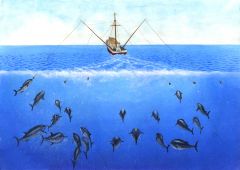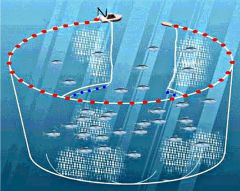![]()
![]()
![]()
Use LEFT and RIGHT arrow keys to navigate between flashcards;
Use UP and DOWN arrow keys to flip the card;
H to show hint;
A reads text to speech;
22 Cards in this Set
- Front
- Back
|
Are fisheries considered a renewable resource? |
Yes, because they regularly replenish their stock. |
|
|
Why are fisheries a unique resource? |
Because they are fugitive, they cross between freshwater (provincially controlled) to saltwater (federally controlled) and over international borders. |
|
|
What are the three types of major technological change associated with fisheries? |
Transport (oar/sail --> steam power --> gas engine), gear (trollers, gillnetters, seiners, refrigeration), and processing methods (salting --> barrelling --> manual canning --> mechanical canning, labour intensity --> capital intensity, and consolidation of canneries) |
|
|
What is trolling? |

Many lines baited with lures strung from boat. |
|
|
What is gillnetting? |

A wall of netting placed in the ocean. |
|
|
What is the seiner method? |

Circular net that hangs in the ocean. |
|
|
What methods are used for the preservation of fish stock? |
Bans, licences, quotas. |
|
|
What methods are used for the enhancement of fish stock? |
Hatcheries, aquaculture. |
|
|
What methods are used for the protection of the fishes' habitat? |
Environmental Impact Assessments. |
|
|
What is a regulating factor of the supply of salmon? |
Their natural cycle. |
|
|
What are regulating factors of the demand of salmon? |
International market situations (depressions), misinformation (rumours that sockeye was dyed), poor quality (improper canning can cause botulism). |
|
|
What did the Davis Report (1968) accomplish? |
The implementation of the reduction of fishing vessels. |
|
|
What did the Commission of Fisheries (1931) bring forward? |
Threat towards U.S. to abandon control of salmon on the Fraser River. |
|
|
What did the Duff Commission (1922) accomplish? |
Allowed motor boats into Northern waters, dropped Japanese licences by 40% because they thought foreign fishing was the sole source of scarcity. |
|
|
What did the Wilmot Commission of 1890 accomplish? |
The reduction of mesh size and closures. |
|
|
What the Wilmot Commission of 1892 accomplish? |
Opened licences to non-cannery fishermen. |
|
|
What did the Pearse Commission (1981) accomplish? |
A 50% reduction of fleet, tied salmon quota to vessel and gear type, introduced licences for sport fishing, and encouraged hatcheries. |
|
|
What did the Sinclair Report (1958) suggest? |
A proposal to restrict fishing vessel licences. |
|
|
What is an Individual Transferable Quota? |
The portion of the annual allowable catch that are allocated to individual fishermen or their vessels, allowing them to buy, sell, trade, or lease them. |
|
|
What is the Catch Quota System? |
The amount that can be caught by an individual vessel per year with no restriction on the number of vessels a licence owner can have. |
|
|
What is Total Allowable Catch? |
The amount that can be caught by ALL individual fishermen with no restriction on amount an individual can catch within that amount. |
|
|
What issues are threatening fish habitats? |
Intrusion due to urbanization, dams. |

